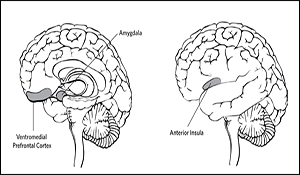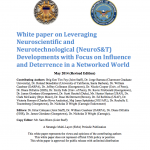NeuroS&T Influence and Deterrence Effects

Leveraging Neuroscientific and Neurotechnological (NeuroS&T) Developments with Focus on Influence and Deterrence in a Networked World.
Author | Editor: Fay, T. Brig Gen (Joint Staff) & Barraza, J. (Claremont Graduate University).
This white volume focuses on possible ways that insights from the neurosciences may be incorporated into, and used within the United States Government’s (USG) approaches and ability to conduct optimized influence and deterrence operations for the purpose of maintaining global stability. In this context, neuroscientific techniques, technologies and information are viewed as viable means to build upon and enhance tactical approaches from other disciplines such as the social sciences. Understanding the neurobiology of human behavior can provide an added dimension to formulating deterrence and influence strategies in the context of a security environment that has become more complex and far more fluid over last few decades. In this white paper, the term “neurodeterrence” refers to the consideration and application of evolutionary neurobiological information about, and understanding of cognition and social behaviors that are important to deterrence theory in contexts of conflict.
Key insights provided by contributing authors that are of particular relevance to the operational community include:
- Modern deterrence must draw on multiple disciplines ranging from physics and engineering to the psychological sciences. Neuroscience and neurotechnology (neuro S/T) might well offer new insights and methods to aid military practitioners and to enhance their decision-making.
- Neurodeterrence is the application and consideration of evolutionary neurobiological bases of cognition, emotion and behaviors that are influential to individual and group aggression and violence. Such information is important to deterrence theory in contexts of understanding, predicting and mitigating/preventing conflict.
- The use of neuro S/T and the information these approaches afford can be important to the interpretation of human behaviors that do not appear to follow rational or mathematical models.
- Equally important is that while neuroscience affords great potential, it is also limited in particular aspects of technical capacity and applicability and, therefore, does not – and should not – provide a stand-alone or absolute toolkit for understanding aggression and violence. Neuroscience should be integrated into the development and evaluation of approaches to influence and deterrence.
- The field of neuroeconomics and related disciplines can provide unique insights to underlying mechanisms of human decision-making and behavior, and therefore are of importance and value to informing new developments in influence and deterrence.
- Improved understanding of the mechanisms of decision making could make important contributions toward effective deterrence. New approaches to deterrence will require consideration of the biases and motivations of decision makers as they approach complex choices. Thinking about deterrence in terms of social partners – rather than opponents – may improve the process of decision making.
- The psychology of revenge is important to explain the evolution of deterrence, which attempts to prevent aggression and overt violence prior to initiation. While characteristically considered in contexts of nuclear armament strategies, deterrence – as a concept and operational construct – predates nuclear weapons, and evolutionary models are useful to explain how deterrence emerged as an approach to individual and group actions aimed at protecting and defending people, objects, and lifestyles of value.
- There is empirical evidence that experiencing a narrative can be transformational, and can induce long-term effects upon audiences’ beliefs, attitudes, and behavioral intentions and actions. Therefore, the prudent use of narratives may be a crucial approach through which to influence the beliefs of those who (are predisposed to) disagree with the position espoused in the persuasive message.
- It is important to consider not only the perspective of the person being influenced but also the potential for each actor to influence others. Preliminary evidence suggests that brain systems implicated in perspective taking and social cognition (e.g., considering ‘how might this idea be of value to others?’ or ‘what will they think of me if I share?’) may be key to understanding individual differences in being a successful idea salesperson.
- Techniques and recent research findings of social neuroscience and neuroeconomics can be useful to predict changes in individual behavior. Studies have shown, for example that neurobiological information in response to persuasive messages can provide more accurate predictions of behavior change than assessment of participants’ own attitudes toward the behavior in question and their intentions to perform the behaviors in question.
- Individual differences in sensitivity to both rewards and punishments are culturally determined to some extent, but also reflect underlying genetic-environmental interactions on a variety of levels.
- Biological events, affecting the brain, and induced by neural functions (i.e. so-called “bottom-up” and “top-down” effects), have been shown to be involved in the formation of trust. Of particular interest in this research has been the putative role of the neuropeptide oxytocin in neurobiological mechanisms of trust formation and execution. Research to date indicates that oxytocin appears to exert influence upon subliminal (i.e. preconscious) perception of social information by increasing attention given to socially-relevant interpersonal and environmental cues (thinking about the “other-in-contexts”) and by lowering sensations of (social) threat. Neuroimaging studies suggest that humans experience trust as rewarding, through activation of key mid- and forebrain networks, which may be important to functional fortification of these networks activity in various social/environmental conditions to reinforce future trust/cooperation.
- The neural phenomenon of “prediction error” can help U.S. policymakers to cause intended effects, and avoid unintended effects, on an adversary in a diplomatic or military confrontation. Prediction error provides a tool to increase or decrease the impact of our actions. A prediction error framework forecasts important effects such as inadvertent escalation; and it simplifies across existing strategic concepts so it can be operationalized without additional analytical burden. It explains historical cases and makes clear policy recommendations for doctrine and practice in China-U.S. escalation scenarios.
- The human capacity for individual and group empathy, and the behaviors fostered by these cognitive-emotional states (e.g. the extent to which altruism supersedes egoism, and empathic emotions repress self-interest) can affect attempts at deterrence in those situations when “stronger threatens weaker”. Simply put: Humans care about groups, and experience strongly emotional reaction to perceived threats to an “in-group”. Such emotionality can affect, influence (and interfere with) more rationalized decision- making relative to engaging behaviors that affect self, and “in-group” or “out-group” others.
- The intersection of new and iterative cyber-based communication technologies (CBCT) and psychological and neurobiological dimensions of behavior should be regarded as a potentially important – and viable – convergence of S/T. Possible applications and implications of such (cyber-neuro) convergence include:
- Synthesizing traditional methods of social influence with recent advances in neuroscience, cyberpsychology, and captology (the study of persuasive technology) toward development of an advanced set of personalized persuasion tactics.
- Establishment and use of chat rooms and other forms of social media to serve as digital echo chambers to effect greater social polarization.
- Novel approaches to crafting effective messages that capitalize on current neurocognitive and anthropological research about individual and group beliefs. Such research has shown that one cannot start by simply crafting a message; rather it is essential to incrementally prepare a person or an environment to make communicated messages credible.
- Combining actor-specific approaches to tailored deterrence methods within the broader neuroscience and technology (neuro S/T) framework can provide a model for operationalizable Neurodeterrence approaches.
Contributing Authors
Brig Gen Tim Fay (Joint Staff), Dr. Jorge Barraza (Claremont Graduate University), Dr. Roland Benedikter (University of California, Santa Barbara), Dr. William Casebeer (DARPA), Dr. Jeffrey Collmann (Georgetown), Dr. Nicole Cooper (Univ. of Penn), Dr. Diane DiEuliis (HHS), Dr. Emily Falk (Univ. of Penn), Dr. Kevin FitzGerald (Georgetown), Dr. James Giordano (Georgetown), Dr. Scott Heuttel (Duke), Mr. Hunter Hustus (USAF), Dr. Clark McCauley (Bryn Mawr), Dr. Rose McDermott (Brown), Dr. Ed Robbins (USAF), Dr. Victoria Romero (Charles River Analytics), Maj Jason Spitaletta (JHU/APL), Dr. Rochelle E. Tractenberg (Georgetown), Dr. Nicholas D Wright (Carnegie Endowment) Editors: Dr. Hriar Cabayan (Joint Staff), Dr. William Casebeer (DARPA), Dr. Diane DiEuliis (HHS), Dr. James Giordano (Georgetown), Dr. Nicholas D Wright (Carnegie)

Comments